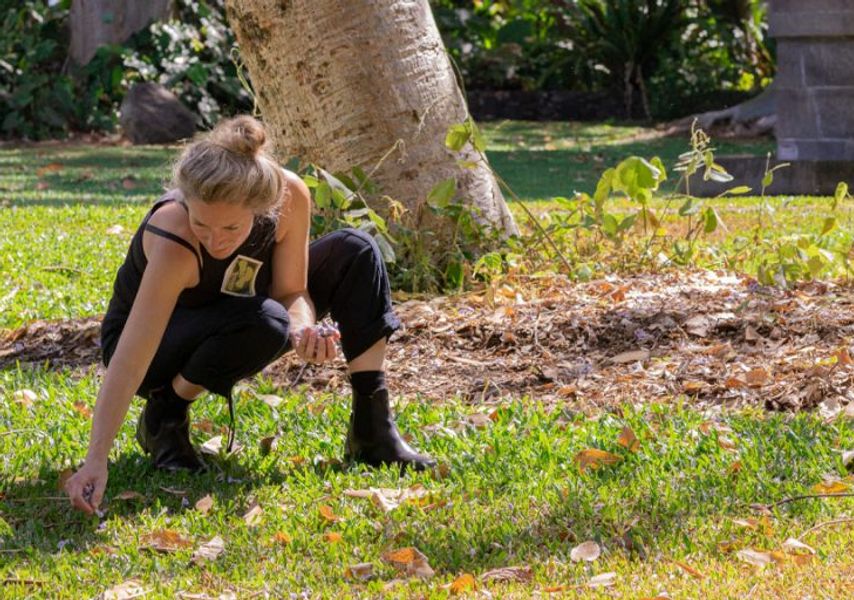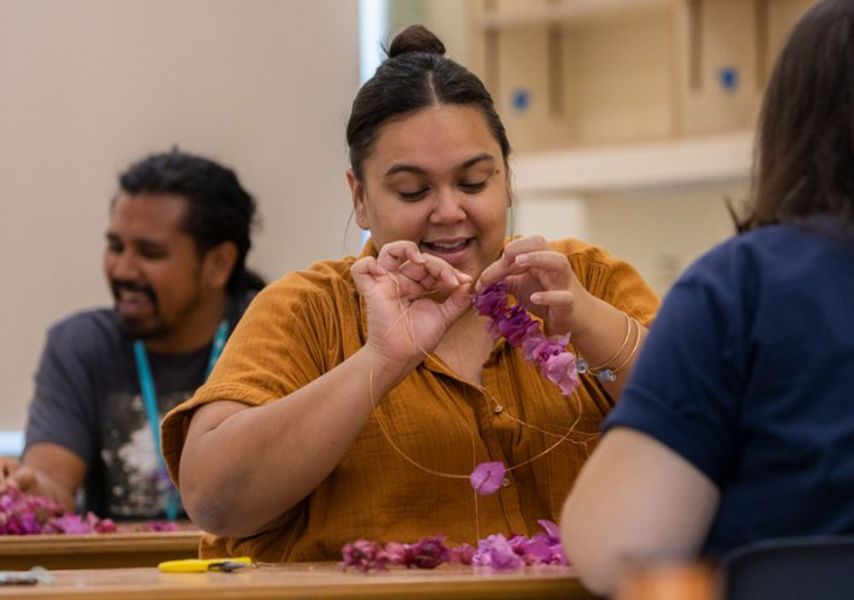Natural Woman: Q+A with Rebecca Louise Law
Rebecca Louise Law “paints” with flowers, seeds, shells and other organic materials—as can be seen in the installation Awakening, now on view through Sept. 10. There is so much to absorb walking amid the cascades of flora. And when you talk to Rebecca, the inspiration and passion she feels for the natural world is palpable. To help you more deeply experience your own “awakening,” we asked the artist some questions. She took the time to respond about her process, her floral heritage, Hawai‘i’s deep relationship to flowers, Émile Zola (!) and climate change.

You have worked largely with temperate climate flora and plants. What has it been like working with tropical flowers? Were there any delightful discoveries and major challenges?
Rebecca Louise Law: I have always wanted to work with bougainvillea, and it has been amazing working with it. Tropical flowers are not known for drying well, but we have had fun seeing what will happen. The plumeria lost its color but the forms are very interesting, they look like a swarm of black butterflies. The team here have put a huge effort into the process of drying and preparing very difficult specimens, I’m amazed by the result.
Of all the local flowers you worked with, did a favorite emerge?
My favourite specimen is the Quipo seed. It has made this artwork glow and quiver in the breeze.
Would you say the UK is one of the most flower-crazy countries in the world? I was thinking, from Capability Brown gardens to William Morris wallpaper to paintings like Millais’ Ophelia, to Liberty of London, and Charlie McCormick, blooms seem to be such an important part of the British cultural landscape. Are you a direct descendent of all that floral history?
My ancestry has a history within art and gardens. My father was the head gardener of a National Trust Property called Anglesey Abbey in Cambridge. Before he retired he was a garden consultant for The National Trust overseeing the East of England and Northern Ireland. I have documentation of up to six generations of gardeners on my Father’s side of our family. My Mother’s ancestor Charles Swinstead started the Hornsey School of Art in London and his sons George Hillyard and Frank Hillyard Swinstead exhibited at the Royal Academy. Many of my relatives have been art teachers, including my Auntie Pam Norman and Uncle Paul Todd. Flowers are present within British culture and have a rich history. The possibilities of creatively working with flowers throughout my life has been made by those who loved the flower before me.

How does Hawai‘i residents’ relationship with flowers compare with that of the UK, from what you’ve experienced?
The art of lei making is entwined within Hawaiian living. I feel such enthusiasm for my concept and an understanding of my practice here. The residents of Hawai‘i needed little instruction whilst helping to wire flowers and brought a confidence to participating that made the whole process very enjoyable.
The UK has a close relationship to flowers, the love of flowers is seen everywhere. When comparing relationships to flowers, I have found that the relationship that the British have with the flower is a little more conservative. The act of loving through the flower is present in both cultures, however the ceremony of giving and receiving a lei is an incredibly vulnerable process. Bringing flowers into another being’s space and adorning the body is a very physical act. Both parties need to participate and the exchange is beautifully sensitive.
As climate change heats up the UK and Europe, along with the rest of the world, what kind of impact does that have on your “paint”—flowers—and how does it affect your work?
Water will most probably affect flower production first. My flowers are grown on a small farm in Normandy, France. I also grow a small percentage in my garden in Wales. Last year the farm lost a huge amount of flowers due to the unpredictable weather. I continue to preserve all I can. I have also encouraged all new installations to use “waste” flowers from the commercial flower businesses. I’m currently working on an exhibition in Munich that has been collecting waste flowers from the city’s events for a year.
Ultimately, I plan to adapt with the flowers, treasuring everything I can. The production of commercial flowers will become very expensive and use a lot of energy. I know that Holland has many new technologies for a more sustainable growing system and these will need to be shared with the rest of the world.
I love working with most natural materials and I am not solely dependent on flowers. Seeds, shells and leaves also feature in artworks. I continue to grow my own and collect from my garden. I did notice that the hotter the weather the quicker the flower comes and goes. Daily inspection of the garden has become vital for cutting the flower at the correct time.
On your website, you are quoted as saying, “My work is often associated with death and decay, but I see it as a preservation of life.” And your installation at HoMA is titled Awakening—which conveys a sense of birth/rebirth and the new. With this work, how do drying flowers evoke a sense of awakening? Or is it the viewer who is awakened by your installation?
Connecting to this Earth and the humans that live on it is vital for survival. I hope that this artwork will awaken the love we have for each other and this earth and inspire the viewer to live responsibly. We are so often striving and the little time we have is swallowed up by commercial distractions. Treasuring all we have on this Earth is at the core of my artworks. I treasure through preservation, I believe that each natural element has so much to give until it turns to dust and returns to the Earth. Discovering the beauty of a flower once it has dried is often an adjustment to how we see. We can rethink what we need and where to spend our time.
The installation is site specific, I’ve been inspired by the local flowers, the local culture and people. I am saddened to include the ocean debris that has settled on these sublime beaches, but there is a very small cluster of waste, unwelcome, but settled in the flowers in my installation. The world needs to look at the damage caused by waste, this artwork is a call for awakening.
The artwork is a physical journey, it starts heavy and dark, gently leading the viewer into the light and I hope it will spark a conscious internal awakening.
You have created installations that are designed to be permanent and others that are temporary, with the material being reused in other projects. What are some preservation techniques you used for Awakening? Do you know yet how the material will be used once the installation is over?
This artwork is made from a collection of installations, sculpted and re-sculpted over the past 18 years. Once this artwork is deinstalled it will be carefully packed and sent to the next exhibition. I now have over a million flowers in my permanent collection. The preservation technique is simply air drying. Dry humidity and UV protection are vital for the flowers’ longevity.
Do you live in a house? If yes, do you keep a garden?
Nearly four years ago I moved from East London to Snowdonia in Wales, where we live in a house with a garden. The previous owners were avid gardeners, so I’ve inherited some incredible plants. I also grow my own flowers from seed each year.
Besides still life painters of the Dutch Golden Age, what/who are other influences on your work?
I was heavily influenced by the color field painters and Mark Rothko was the closest I could get to physically experiencing color. I’ve also greatly admired Olafur Eliasson—his [2003] weather project installation in the turbine hall at Tate Modern in London was the first installation that took my breath away. I was influenced by Emile Zola’s book The Sinful Priest, his use of flowers to describe life and the conflict between religion and nature always fascinated me. I made a short film to try and capture an essence of his writings.
Posted by Lesa Griffith on February 20 2023


